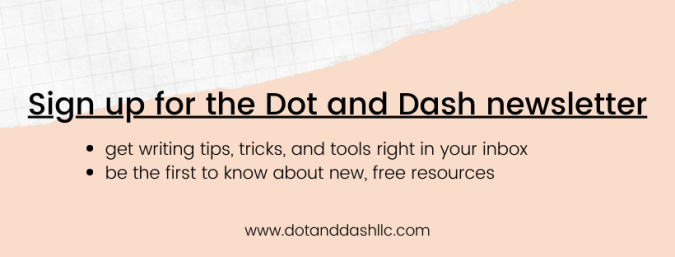Welcome to part one of a three-part series about horizontal fun in the punctuation department: the em dash, the en dash, and the hyphen. Through this series, you’ll learn the difference between these marks and when to use which one.
Let’s take these marks from longest to shortest. That means we are going to discuss the em dash first.
Em dash basics
The em dash received its name from typesetting. It is the width of a letter m, hence the name em dash.
The em dash is used to show :
- emphasis
- interruption
- sudden breaks in thought
- lists
- quote attribution
When used to show emphasis, interruption, sudden breaks in thought, and lists, em dashes may replace commas, semicolons, or colons. Because dashes are meant to be used sparingly, they have a greater impact than commas, semicolons, and colons—and they can really pump up the volume on your sentence.
Em dash used for emphasis
Think about when you’re telling a story or a lecture or explaining rules to someone, and you have come to the place where you want to make a main point. You pause, right? You pause to alert the listener that something important is coming. When translated to text, this is where you would use an em dash for emphasis. The main point is one example of when you would want to use emphasis. You could also use emphasis to show danger or excitement and for gobs of other reasons.
Here are some examples:
Class, there is a squiggly line on the board—this is very important—don’t ever divide the horseshoe by the squiggly line.
Don’t ever divide the horseshoe by the squiggly line—especially you in the back row.
One time I divided the horseshoe by the squiggly line—and the building blew up.
Em dash used for interruption
If you read fiction, you’ll probably recognize this use of the em dash from dialogue. It looks something like this:
“I want you to know that I—,” Sarah began to say.
Or this:
“I want you to know that I—”
“What?” Cal interrupted. “You love me?”
Em dash used for sudden breaks in thought
If you’re like me, then you usually have a hundred thoughts going through your head at any given moment. (Unless you’re eating cookies. Then you just concentrate on how delicious those cookies are.) The em dash is also used to illustrate when another thought jumps into a sentence.
Here are some examples:
Those cookies—oh boy, were they delicious—came from Marsha’s bakery.
Those cookies—the ones with the raisins in them—were a gift from Sam.
Sam—he’s such a good guy—buys me cookies every Tuesday.
Em dash used for lists
The em dash does a good job of setting off lists when using commas or a mix of commas and semicolons would make your sentence look too clunky.
Here are some examples:
Three people—Sam, Sarah, and Cal—went to math class together.
They learned that some mathematical characters—the horseshoe and the squiggly line—can be dangerous.
After math class, they did two things—studied for their test and ate cookies.
Em dash used for quote attribution
When listing the author of a quote, you’ll sometimes see an em dash before the author’s name, like this:
Live long and prosper.
—Spock
If I were human, I believe the correct response would be “Go to hell.”
—Spock
How to make an em dash
In most cases, Microsoft Word automatically makes an em dash for you when you type two hyphens. Simply type the first word, then (without hitting the space bar) type two hyphens, and then (without hitting the space bar) type the second word. When you finally hit the space bar after typing the second word, the two hyphens turn into an em dash.
However, there are circumstances, such as when using the em dash for quote attribution, when this won’t work. In these cases, use the steps below.
- In Microsoft Word, go to the Insert tab.
- Click Symbol from the drop down box.
- Click Special Characters.
- Click Em Dash.
- Click Insert.
Spaces around em dash?
The answer about whether to put spaces around em dashes depends on which style guide you use. The Chicago Manual of Style says not to put spaces. But, the Associated Press Stylebook says to put spaces.
If you are writing something that requires the authority of a particular style guide, then check that guide for the answer. If you are writing something for work, inquire whether your company has a house style guide, and check there first to see if it has a ruling on the spaces issue.
Be sure to check back for parts two and three of this series to learn how to use en dashes and hyphens. As always, you can also follow me on Twitter at @GrammarParty.



